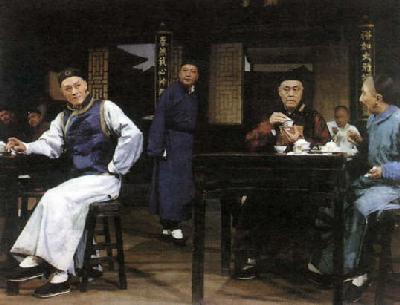| Art Q&A > Drama |
|
|
Lao She's Teahouse
Published in 1957, Teahouse is not only a peak of Lao She's dramatist career but also a monumental work in the history of modern Chinese drama.
Through a graphic depiction of what happened to a teahouse in Beijing and the fate of Wang Lifa, boss of the teahouse and that of a group of characters connected therewith, Teahouse mirrored the then social turmoil and the seamy side of society. The first act described the corrupt and moribund Qing Dynasty after the Reform Movement of 1898. The second act portrayed the dogfight between warlords in the initial years after the founding of the Republic of China (1912-1949), for which the ordinary people could hardly earn a living. The third act pictured the Kuomintang's cruel government in Beijing after the victory of the War of Resistance Against Japan.
The successful performance of Teahouse by Beijing People's Art Theater would be unimaginable without Jiao Juyin (1905-1975), the general director for the play. As a play filled with many characters from different historical periods, Teahouse posed a severe challenge to the director. However, Jiao Juyin had not only acquired a good command of the play but also turned it into a national poem.
The teahouse in the play serves not only as a stage set but also a poetic symbol. The changes that took place there represented the historical evolution. |
||||
All rights reserved. Reproduction of text for non-commercial purposes is permitted provided that both the source and author are acknowledged and a notifying email is sent to us. |
||||
 |
